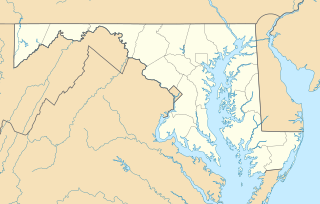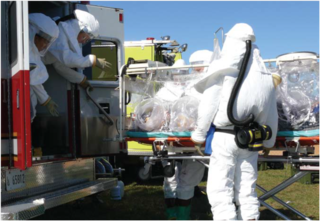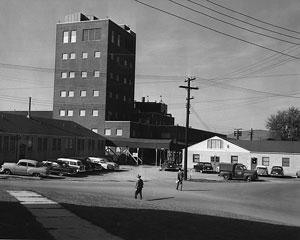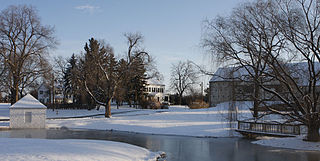 W
WFort Detrick is a United States Army Futures Command installation located in Frederick, Maryland. Historically, Fort Detrick was the center of the U.S. biological weapons program from 1943 to 1969. Since the discontinuation of that program, it has hosted most elements of the United States biological defense program.
 W
WThe Aeromedical Isolation Team of the US Army Medical Research Institute of Infectious Diseases (USAMRIID) at Fort Detrick, Maryland was a military rapid response team with worldwide airlift capability designed to safely evacuate and manage contagious patients under high-level (BSL-4) bio-containment conditions. Created in 1978, during its final years the AIT was one of MEDCOM’s Special Medical Augmentation Response Teams comprising a portable containment laboratory along with its transit isolators for patient transport. Contingency missions included bioterrorism scenarios as well as the extraction of scientists with exotic infections from remote sites in foreign countries. The AIT trained continuously and was often put on alert status, but only deployed for “real world” missions four times. The AIT was decommissioned in 2010 and its mission assumed by one of the US Air Force’s Critical Care Air Transport Teams (CCATTs).
 W
WBuilding 470 — also called the Pilot Plant, or sometimes “the Tower”, or “Anthrax Tower” — was a seven-story steel and brick building at Fort Detrick in Frederick, Maryland, United States, used in the small-scale production of biological warfare (BW) agents. The building, a Cold War era structure, was transferred from the Department of Defense to the National Cancer Institute-Frederick in 1988, to which it belonged until 2003 when it was demolished.
 W
WThe Forest Glen Annex is a 136-acre (0.55 km2) U.S. Army installation in the Forest Glen Park neighborhood of Silver Spring, Maryland, USA. It is situated between Brookville Road and Linden Lane. Since 1999, the Annex has been the site of the Walter Reed Army Institute of Research (WRAIR) and the Naval Medical Research Center (NMRC), along with smaller units. In addition to the large research laboratories located in the Annex's "Daniel K. Inouye Building", the post includes a commissary, a child care center, and a Fisher House. There are also football and baseball fields, and picnicking facilities. In 2011, in accordance with the most recent Base Realignment and Closure (BRAC) recommendations, the Forest Glen Annex became home to the National Museum of Health and Medicine (NMHM) as well as a "Joint Center of Excellence in Infectious Disease Research." The former Army and Air Force Exchange Service (AAFES) post exchange was repurposed as office space and a new Navy Exchange (NEX) was opened at the nearby Walter Reed National Military Medical Center in Bethesda, Maryland.
 W
WThe Nallin Farm House and the related Nallin Farm Springhouse and Bank Barn are located on Fort Detrick at Frederick, Maryland.
 W
WThe Nallin Farm Springhouse and Bank Barn are closely associated with the Nallin Farm House on the grounds of Fort Detrick, Maryland, US. The barn is a good example of a fieldstone-built bank barn with a byre on the lower level and an earth ramp on the opposite side providing access to a haymow.
 W
WThe One-Million-Liter Test Sphere—also known as the Test Sphere, the Horton Test Sphere, the Cloud Study Chamber, Building 527, and the “Eight Ball” —is a decommissioned biological warfare (BW) chamber and testing facility located on Fort Detrick, Maryland, USA. It was constructed and utilized by the U.S. Army Biological Warfare Laboratories as part of its BW research program from 1951 to 1969. It is the largest aerobiology chamber ever constructed and was placed on the National Register of Historic Places in 1977.
 W
WOperation Whitecoat was a biodefense medical research program carried out by the United States Army at Fort Detrick, Maryland between 1954 and 1973. The program pursued medical research using volunteer enlisted personnel who were eventually nicknamed "Whitecoats". These volunteers, all conscientious objectors, including many members of the Seventh-day Adventist Church, were informed of the purpose and goals of each project before providing consent to participate in any project. The stated purpose of the research was to defend troops and civilians against biological weapons and it was believed that the Soviet Union was engaged in similar activities.
 W
WThe Telemedicine and Advanced Technology Research Center (TATRC) performs medical reconnaissance and special operations to address critical gaps that are underrepresented in DoD medical research programs. TATRC is an office of the headquarters of the US Army Medical Research and Materiel Command (USAMRMC).
 W
WThe U.S. Army Biological Warfare Laboratories (USBWL) were a suite of research laboratories and pilot plant centers operating at Camp Detrick, Maryland, United States beginning in 1943 under the control of the U.S. Army Chemical Corps Research and Development Command. The USBWL undertook research and development into biocontainment, decontamination, gaseous sterilization, and agent production and purification for the U.S. offensive biological warfare program. The laboratories and their projects were discontinued in 1969.
 W
WThe United States Army Medical Research Institute of Infectious Diseases is the U.S Army's main institution and facility for defensive research into countermeasures against biological warfare. It is located on Fort Detrick, Maryland and is a subordinate lab of the U.S. Army Medical Research and Development Command (USAMRDC), headquartered on the same installation.